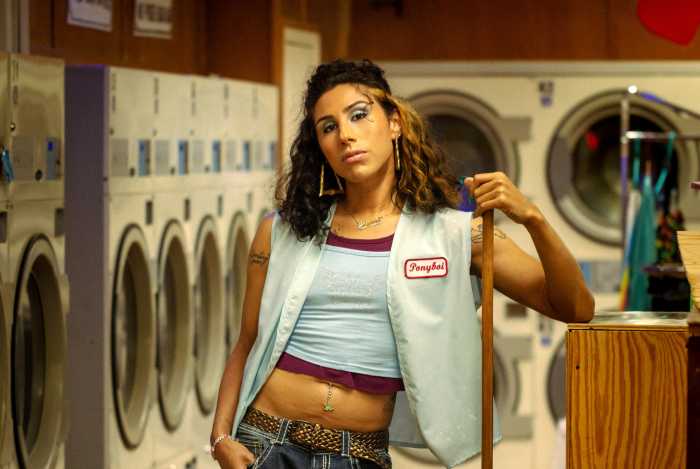BY ELI JACOBSON | The Paris Opéra Ballet performed “Giselle” on its recently completed US tour, but also presented the late Pina Bausch’s dance-opera staging of Christoph Willibald Gluck’s “Orpheus and Eurydice.”
Stephane Buillion (far left) Maria Riccarda Wesseling (mezzo-soprano, seated in black), and Marie-Agnes Gillot (standing, far right) with members of the Paris Opera Ballet. | Stephanie Berger
The company is known for its classical ballet style, rigorous technical standards, and lack of overt theatricality. When it was announced that the temple of classical ballet was performing a work by the modern muse of dance theater, it seemed a perverse case of institutional miscasting. The success of the experiment is a tribute to the Bausch’s genius and the versatility and discipline of the Paris Opera Ballet. Bausch’s work returned the ballet company to its original 17th-century roots blending dance and opera in one spectacle.
Bausch, who died in 2009, first staged “Orpheus” in 1975 for her company the Tanztheater Wuppertal. She restaged the piece in 1991 and it came to the Paris Opéra Ballet two years later.
The piece was presented as part of the Lincoln Center Festival and closed on July 22.
Since it was originally staged in Germany, the vocal parts are performed in German though Gluck created his own French version for high tenor. Similar to the Hector Berlioz adaptation, the title role was given to a female alto. The added French dances — the Dance of the Furies and the Dance of the Blessed Spirits — were rightfully included. Bausch removed Gluck’s happy ending; Love does not restore Eurydice to Orpheus, and Orpheus expires uniting the lovers in death while the chorus repeats the mourning lament from Act I. Bausch saw the work as an abstract journey from grief through stages of violent denial to peaceful acceptance to an embrace of death itself.
Each protagonist is represented by a singer and a dancer. Bausch’s style is not representational — the dancers embody the inner life of the characters and the emotional colors of the music. Symbolic imagery abounds, one tormented spirit in Hades grasped for a suspended apple that was always out of reach. The singers present the exterior action of the characters in simple stylized gestures that contrast with the angular, frenetic movements of the dancers.
The dancers wore costumes in many colors while the singers wore simple, black unisex gowns. The lack of surtitles and Bausch’s evasion of naturalistic realism left many in the audience unfamiliar with the opera and German at a loss. Those who craved fouettés and pirouettes were further vexed.
The German choreographer showed a brilliant handling of mass movement, but also trusted stillness and simplicity. Seeing that the melody of Orpheus’ aria “Che faro senza Euridice” (sung auf deutsch) created all the emotion and dramatic tension necessary, Bausch has the dancing Orpheus prostrated, frozen in grief upstage, back to the audience while the singing Orpheus sings the lament downstage front while cradling the body of his dead wife. Everything is still except for the music that fills the stage, the hearts, and the minds of listeners.
Bausch’s dance vocabulary is based on tension and release, and her focus is on psychological and emotional energy working through the movements of the body. The French dancers’ clarity, control, and precision gave one a sense of seeing the choreography in high definition. There were no blurry lines and shapes and contrasts clearly emerged.
Marie-Agnes Gillot as Eurydice. | Stephanie Berger
Stéphane Bullion, the dancing Orpheus, channeled strong emotion from his elegant semi-nude frame with a mixture of abandon and strict control. Marie-Agnès Gillot, a tall imposing classical ballerina with a penchant for modern ballet (the company’s correlate to Martine Van Hamel and Wendy Whelan), also had a cool, controlled intensity as Eurydice.
Bausch’s choreography is fully a part of the onstage environment. The sets and costumes, by her late husband and collaborator, Rolf Borzik, create stark and varied expressionist landscapes that are integral to her vision.
The musical elements under the baton of baroque specialist Thomas Hengelbrock were first-rate. The musicians and singers of the Balthasar-Neumann Ensemble und Chor (the chorus sang from the pit) performed Gluck’s music with clarity and elegance. Mezzo-soprano Maria Riccarda Wesseling as Orpheus had a dark, expressive tone that lacked some definition and strength at the register extremes. Yun Jung Choi as Eurydice and Zoe Nicolaidou as Amor might have profitably swapped roles. Choi’s bright, straight-toned soprano seemed better suited to the perky god of love than Nicolaidou’s darker, more womanly soprano.
The Paris Opéra Ballet was founded in 1669 and is the oldest national ballet company in the world. It hasn’t been seen in New York since 1996. For New York area music and dance lovers, Orpheus’ journey of loss was a journey of discovery and artistic enrichment.


































